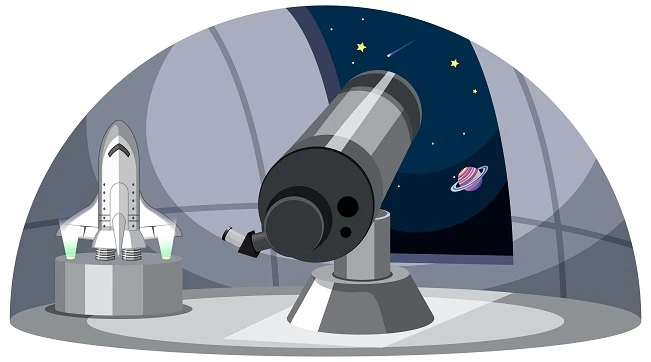The vastness of space and its mysteries has always been a profound source of amazement and curiosity for countless people. Consequently, many nations have invested heavily in research to quench humanity’s insatiable thirst for knowledge, aiming to discover new facts and deepen our understanding of cosmic energy and the universe with Euclid Space Telescope. Notably, space exploration initiatives continue to provide insights that captivate and inspire.
The human race has long been captivated and amazed by the infinite expanse of the cosmos. In a groundbreaking effort to uncover the mysteries of dark matter, dark energy, and the evolution of the universe, the European Space Agency (ESA), in partnership with SpaceX, launched the Euclid Space Telescope. This ambitious mission seeks to survey 36% of the sky, offering an unprecedented glimpse into the universe. Consequently, it is expected to reveal mysteries that no one on Earth has yet unveiled.
What is the Euclid Space Telescope?
The Euclid Space Telescope, a cutting-edge device combining advanced optics and electronics, was launched aboard SpaceX’s Falcon 9 rocket. Named after the renowned Greek mathematician Euclid, the telescope is designed to map the geometry of the cosmos with a particular focus on regions dominated by dark matter and dark energy.
Importantly, Euclid operates from Lagrange Point 2 (L2), a stable region in space located approximately 1.5 million kilometers from Earth. From this strategic vantage point, the telescope minimizes interference, ensuring high-quality data collection. As a result, scientists can use the data to delve deeper into the enigmatic dark matter and dark energy that permeate the universe.
Mission Goals and Objectives of Euclid Space Telescope
The Euclid mission is underpinned by two primary objectives:
- Comprehending Dark Energy and Dark Matter
- Scientists estimate that ordinary matter constitutes only about 5% of the universe. Meanwhile, dark matter (27%) and dark energy (68%) account for the remaining 95%. These elusive components influence the universe’s expansion and structure, yet their true nature remains unknown. Therefore, Euclid aims to shed light on these cosmic enigmas.
- Creating a Three-Dimensional Map of the Universe
- Over the next decade, Euclid will observe billions of galaxies across a span of 10 billion light-years to construct a comprehensive 3D atlas of the cosmos. Consequently, this atlas will enhance our understanding of galaxy distribution and the evolution of cosmic structures.
Key Features of Euclid
Euclid boasts several advanced features that enable its groundbreaking mission:
- Broad-Field Telescope
- Equipped with a 1.2-meter mirror, Euclid captures light at visible and near-infrared wavelengths, allowing it to observe distant and faint objects.
- Superior Detectors
- The telescope employs two main instruments: the Visible Imaging Channel (VIS) and the Near Infrared Spectrometer and Photometer (NISP). Together, these tools provide high-resolution images and spectral data.
- High-Accuracy Measurements
- Thanks to its sophisticated design, Euclid can determine the positions and shapes of galaxies with unprecedented precision. As a result, it provides critical insights into the subtle influences of dark matter and dark energy.
Significance of Surveying 36% of the Sky
Euclid’s survey encompasses an immense scope. By observing over one-third of the sky, the telescope examines diverse cosmic environments, ranging from vast voids to dense galaxy clusters. This comprehensive coverage is essential for understanding the universe’s large-scale structure and the interplay of its components.
The Role of SpaceX in the Mission
SpaceX played a pivotal role in Euclid’s successful launch. Its Falcon 9 rocket, renowned for its reliability and cost-efficiency, ensured the telescope’s precise deployment. This collaboration underscores SpaceX’s growing influence in advancing space exploration.
Potential Discoveries with Euclid Space Telescope
The Euclid mission holds the potential to revolutionize our understanding of the universe. Some anticipated discoveries include:
- Unveiling the Nature of Dark Matter
- By examining dark matter’s interactions with light and ordinary matter, Euclid may reveal critical insights into its composition.
- Advancing Knowledge of Cosmic Expansion
- Euclid’s study of dark energy could challenge existing physics theories and provide explanations for the universe’s accelerated expansion.
- Enhancing Understanding of Galaxy Formation
- The telescope’s data will illuminate how galaxies have evolved over billions of years, offering a clearer picture of cosmic history.
Challenges and Future Prospects
Despite its promise, the Euclid mission faces significant challenges, particularly in data processing and interpretation. The enormous volume of data requires global collaboration and advanced computational techniques. Extracting meaningful information from such vast datasets is a tedious task that demands the expertise of space scientists worldwide. Furthermore, ensuring data security to prevent potential misuse is a critical concern.
Nevertheless, the knowledge gained from Euclid will pave the way for future missions, such as NASA’s James Webb Space Telescope and ESA’s Athena X-ray Observatory. These missions will build on Euclid’s findings, further unraveling the cosmos’ secrets.
Conclusion
The Euclid Space Telescope heralds a new era in space exploration. By aiming to study dark matter, dark energy, and the universe’s evolution, it promises groundbreaking discoveries that will deepen our understanding of the cosmos. As Euclid surveys 36% of the sky and tackles mysteries that have baffled astronomers for decades, it stands as a testament to human ingenuity, collaboration, and curiosity. Ultimately, this mission represents a beacon of hope, inspiring humanity to venture further into the unknown and uncover rare and transformative insights that could reshape life on Earth.





